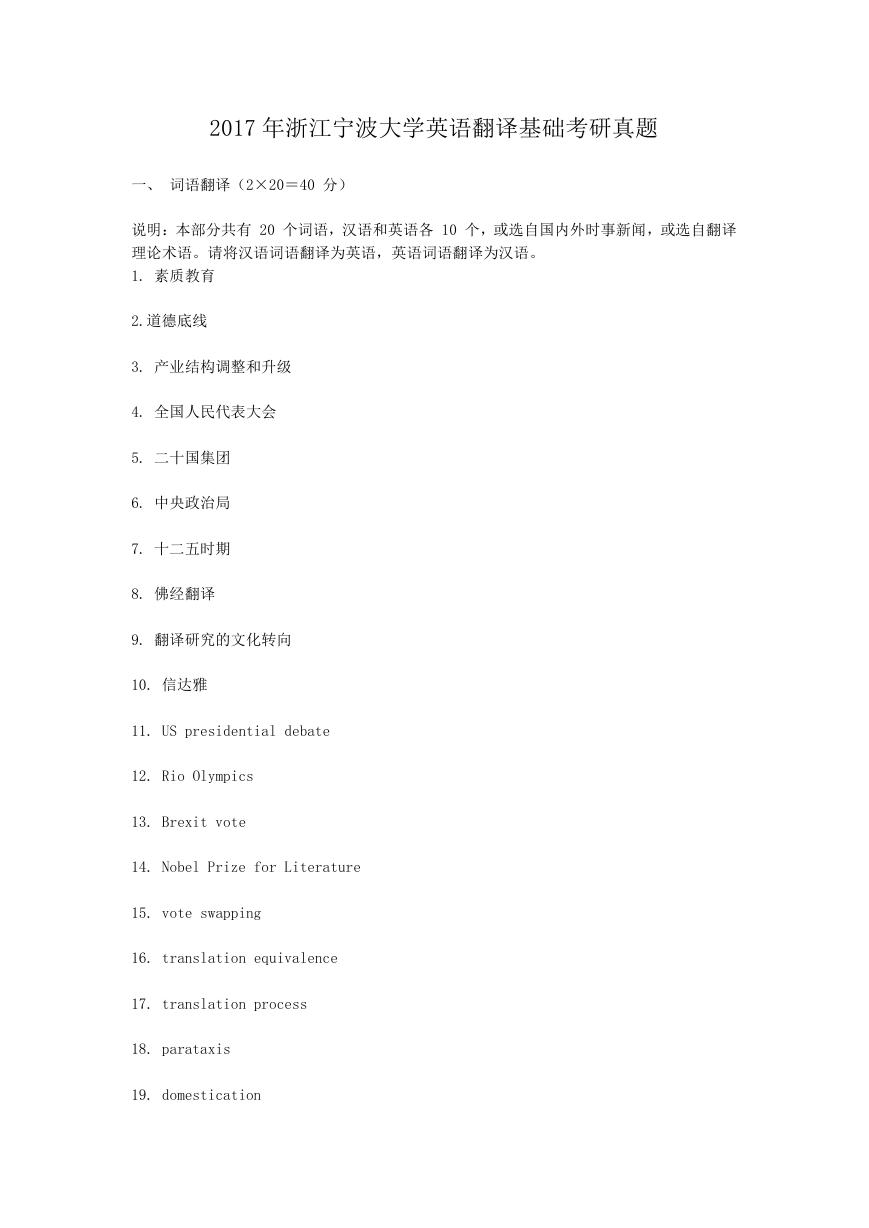2017 年浙江宁波大学英语翻译基础考研真题
一、 词语翻译(2×20=40 分)
说明:本部分共有 20 个词语,汉语和英语各 10 个,或选自国内外时事新闻,或选自翻译
理论术语。请将汉语词语翻译为英语,英语词语翻译为汉语。
1. 素质教育
2.道德底线
3. 产业结构调整和升级
4. 全国人民代表大会
5. 二十国集团
6. 中央政治局
7. 十二五时期
8. 佛经翻译
9. 翻译研究的文化转向
10. 信达雅
11. US presidential debate
12. Rio Olympics
13. Brexit vote
14. Nobel Prize for Literature
15. vote swapping
16. translation equivalence
17. translation process
18. parataxis
19. domestication
�
20. deep structure
二、英汉篇章翻译(1×60=60 分)
Just off the west coast of present-day Scotland, lies the small island of Iona (艾
奥纳岛), a grassy promontory with white sandy beaches, rising up out of the North
Sea. Today it is a place of quiet contemplation, relatively undisturbed by the tour
groups or visiting school children wandering among its enchanted ruins. Even for
those who know, it is easy to forget that twelve centuries ago, these idyllic shores
were the scenes of unimaginable violence.
The monastery of Iona is the symbolic heart of Scottish Christianity, one of the
oldest and most important religious centers in Western Europe. It was founded by
the Irish monk Columba in the sixth century and became the focal point for the spread
of the faith throughout Scotland.
In the early centuries, the monks came to seek seclusion among the ‘desert’ of
the Atlantic Ocean, and built simple beehive-shaped stone huts where they could
concentrate on their prayers and vows of poverty and obedience. Over time, however,
the small community became a major pilgrimage site, and a great medieval center of
learning. It developed into a training school for monks with special rooms for the
copying of manuscripts called scriptoriums(抄写室) that produced works of art
famous throughout Europe. Chief among these was the Book of Kells, an illuminated
collection of the four gospels that was described by its Irish contemporaries as
“the most precious object in the western world”.
In addition to its religious treasures, Iona also boasted an unrivaled collection
of royal tombs. Most of the early Scottish kings, including the two made famous by
Shakespeare – Macbeth and his victim Duncan – were interred in the monastery’s
crypt.
For centuries, the island was an oasis of peace, protected by the faith of its
inhabitants and the vast ocean surrounding it. In 794, however, a ripple of fear
penetrated the tranquility. Rumors reached the monks of terrible raids to the east,
sister monasteries devastated by strange northern pagans. Early the next year, while
the monks were celebrating a holy day, ships with prows carved to resemble serpents
and dragons slipped onto the beach below the main abbey. Leaping onto the white sand
of a shoreline, which would later bear the name ‘Martyr’s Bay’ in memory of the
slain, the raiders headed for the buildings, cutting down the monks they found along
the way. Smashing open the doors, they killed anyone who tried to resist, drenching
the stone floors of the chapel with blood. Anything that looked valuable was seized,
including rich vestments which were ripped off of the bodies of the dead or dying.
As the surviving monks fled in all directions, the attackers set fire to the great
�
abbey and then raced down to the beach with their considerable loot. Seemingly in
the blink of an eye they were gone. Left behind were bloody corpses, burning buildings,
and a shattered community.
Virtually the only thing left intact was the high cross of St. Martin’s, one of
a dozen or so large carved monoliths that had dotted the landscape. In the side facing
away from the devastated church was carved the biblical figure of Abraham with his
sword raised high – as if in warning of the terrible events that had just unfolded.
The raids on the British Isles were only the beginning of a great hammer blow that
fell on an unprepared Europe. The broken bodies and the blackened shells of buildings
in places like Iona would be all too common in the centuries to come.
The suddenness of the violence left many occupants of Europe disoriented and anxious.
The shock and despair can still be felt in the words of Alcuin(阿尔昆), an Anglo-Saxon
monk writing from Charlemagne’s imperial capital of Aachen after one of the first
raids.
“...never before in Britain has such a terror appeared as this we have now suf ered
at the hands of the heathen.”
The fact that the word ‘Viking’ (维京) still conjures up that image of blond-haired
barbarians leaping off of dragon ships to plunder a monastery – is a testament to
the trauma inflicted on Western Christendom during the three hundred years of the
Viking Age. It is burned into our collective memory.
三、汉英篇章翻译(30+20=50 分) 说明:本部分包含 2 篇汉语短文,请翻译为英语。
1. 保护绿水青山,留住蓝天白云,是全体人民福祉所系,也是对子孙后代义不容辞的责任。
必须始终把建设生态文明、保护生态环境放在突出位置,强化科学治理,推广适用技术,实
行最 严格的源头保护制度,严守生态保护红线,以重点区域和关键领域为抓手,实施重大
战略性生态 工程,充分发挥市场作用,调动各类社会主体投身生态保护和建设的积极性,
坚持在发展中保护、 在保护中发展,让当代人受益,为中华民族永续发展奠定坚实基础。
2. 古之学者必有师。师者,所以传道受业解惑也。人非生而知之者,孰能无惑?惑而不从
师, 其为惑也,终不解矣。生乎吾前,其闻道也,固先乎吾,吾从而师之;生乎吾后,其
闻道也,亦 先乎吾,吾从而师之。吾师道也,夫庸知其年之先后生于吾乎?是故无贵无贱,
无长无少,道之 所存,师之所存也。
�






 2023年江西萍乡中考道德与法治真题及答案.doc
2023年江西萍乡中考道德与法治真题及答案.doc 2012年重庆南川中考生物真题及答案.doc
2012年重庆南川中考生物真题及答案.doc 2013年江西师范大学地理学综合及文艺理论基础考研真题.doc
2013年江西师范大学地理学综合及文艺理论基础考研真题.doc 2020年四川甘孜小升初语文真题及答案I卷.doc
2020年四川甘孜小升初语文真题及答案I卷.doc 2020年注册岩土工程师专业基础考试真题及答案.doc
2020年注册岩土工程师专业基础考试真题及答案.doc 2023-2024学年福建省厦门市九年级上学期数学月考试题及答案.doc
2023-2024学年福建省厦门市九年级上学期数学月考试题及答案.doc 2021-2022学年辽宁省沈阳市大东区九年级上学期语文期末试题及答案.doc
2021-2022学年辽宁省沈阳市大东区九年级上学期语文期末试题及答案.doc 2022-2023学年北京东城区初三第一学期物理期末试卷及答案.doc
2022-2023学年北京东城区初三第一学期物理期末试卷及答案.doc 2018上半年江西教师资格初中地理学科知识与教学能力真题及答案.doc
2018上半年江西教师资格初中地理学科知识与教学能力真题及答案.doc 2012年河北国家公务员申论考试真题及答案-省级.doc
2012年河北国家公务员申论考试真题及答案-省级.doc 2020-2021学年江苏省扬州市江都区邵樊片九年级上学期数学第一次质量检测试题及答案.doc
2020-2021学年江苏省扬州市江都区邵樊片九年级上学期数学第一次质量检测试题及答案.doc 2022下半年黑龙江教师资格证中学综合素质真题及答案.doc
2022下半年黑龙江教师资格证中学综合素质真题及答案.doc